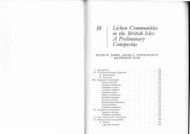Create successful ePaper yourself
Turn your PDF publications into a flip-book with our unique Google optimized e-Paper software.
in the descriptions the term “subhydrophytic” is<br />
used.<br />
Amphibious species are temporarily flooded<br />
(streams, or rivers). Species living submerged<br />
colonize almost constantly flooded sites.<br />
4.2.2 Climate<br />
The climatic reality <strong>of</strong> the lichen habitat is<br />
indicated in the main with the aid <strong>of</strong> a statement<br />
about the light available, relative humidity, the<br />
measure “rainfall” and frequently the<br />
temperature relations.<br />
Moistening by rain: The measure <strong>of</strong> the<br />
moistening <strong>of</strong> the habitat with rain is <strong>of</strong><br />
considerable influence on the habitat selection.<br />
Many species live only on rain excluded sites.<br />
Habitat: Lichen:<br />
very rain-protected very anom-<br />
bryophytic<br />
rather rain-protected anombrophytic<br />
moderately rained-on m. ombrophytic<br />
rather rained-on r. ombrophytic<br />
very (strongly) rained-on v. ombrophytic<br />
The habitats not or only exceptionally rain<br />
moistened were designated as very rain<br />
protected sites. In the case <strong>of</strong> rather rain<br />
protected sites, moistening occurs only<br />
occasionally and relatively belatedly. The<br />
stem-dwelling lichens and the species on vertical<br />
and subvertical surfaces may be counted as<br />
normally in a moderately rained-on habitat. Here<br />
designated as very ombrophytic were only<br />
lichens <strong>of</strong> frequently rained-on surfaces in heavy<br />
precipitation regions.<br />
Humidity: Statements about the humidity<br />
relationships are only to be understood as a crude<br />
orientation. They are only made with difficulty<br />
and are problematic. The following gradations<br />
are found:<br />
Habitat: <strong>Lichens</strong>:<br />
extremely humid e. hygrophytic<br />
very humid v. hygrophytic<br />
rather humid r. hygrophytic<br />
moderately humid, or<br />
moderately dry air mesophytic<br />
rather dry air r. xerophytic<br />
very dry air v. xerophytic<br />
Oceanic (as a climatological conception):<br />
<strong>Lichens</strong> were designated as strongly oceanic<br />
(very oceanic), which depend upon very high<br />
rainfall or foggy and very/extremely humid<br />
places with mild temperatures (relatively small<br />
temperature variations) (above all high places<br />
and west exposures <strong>of</strong> the Vogesen, or the Black<br />
Forest). For rather oceanic lichens similar<br />
values, but less pronounced conditions (mostly<br />
high rainfall, rather mild climate). Rainfall<br />
occurring is <strong>of</strong> paramount importance <strong>of</strong> the<br />
factors determining moisture relationships. Fog<br />
and (less so) humidity may partially compensate<br />
for the amount <strong>of</strong> rainfall.<br />
Light: Light conditions are characterized as<br />
follows:<br />
Habitat: Plants:<br />
v. poorly v. skiophytic deep shade<br />
lighted plants<br />
r. poorly r. skiophytic shade plants<br />
lighted<br />
m. well m.photophytic half-shade<br />
lighted plants<br />
v. well v. photophytic Full light<br />
lighted plants<br />
Plants with a relatively very wide ecological<br />
amplitude <strong>of</strong> light use were designated as<br />
photoindifferent.<br />
Statements about the preferred occurrence <strong>of</strong><br />
lichen species in certain vegetation types or land<br />
forms may give further indication about climatic<br />
conditions <strong>of</strong> the habitat. Thus species which are<br />
designated as characteristic for forest regions,<br />
commonly live on wind-protected sites with<br />
relatively balanced moisture conditions.<br />
4.3 Statements About the Sociology<br />
Like flowering plants certain lichen species<br />
frequently occur associated with one another.<br />
Numerous such typical combinations <strong>of</strong> lichen<br />
species found again and again have been<br />
described as lichen communities. For the naming<br />
<strong>of</strong> such communities certain rules are valid,<br />
which are laid down in a code <strong>of</strong> plant sociologic<br />
nomenclature.<br />
So far as the community names are produced from<br />
species names, which are no longer in use, they were<br />
altered here according to today’s valid species names,<br />
without the code <strong>of</strong> plant sociologic nomenclature<br />
20





